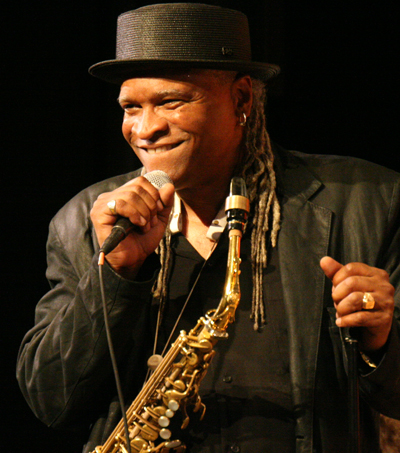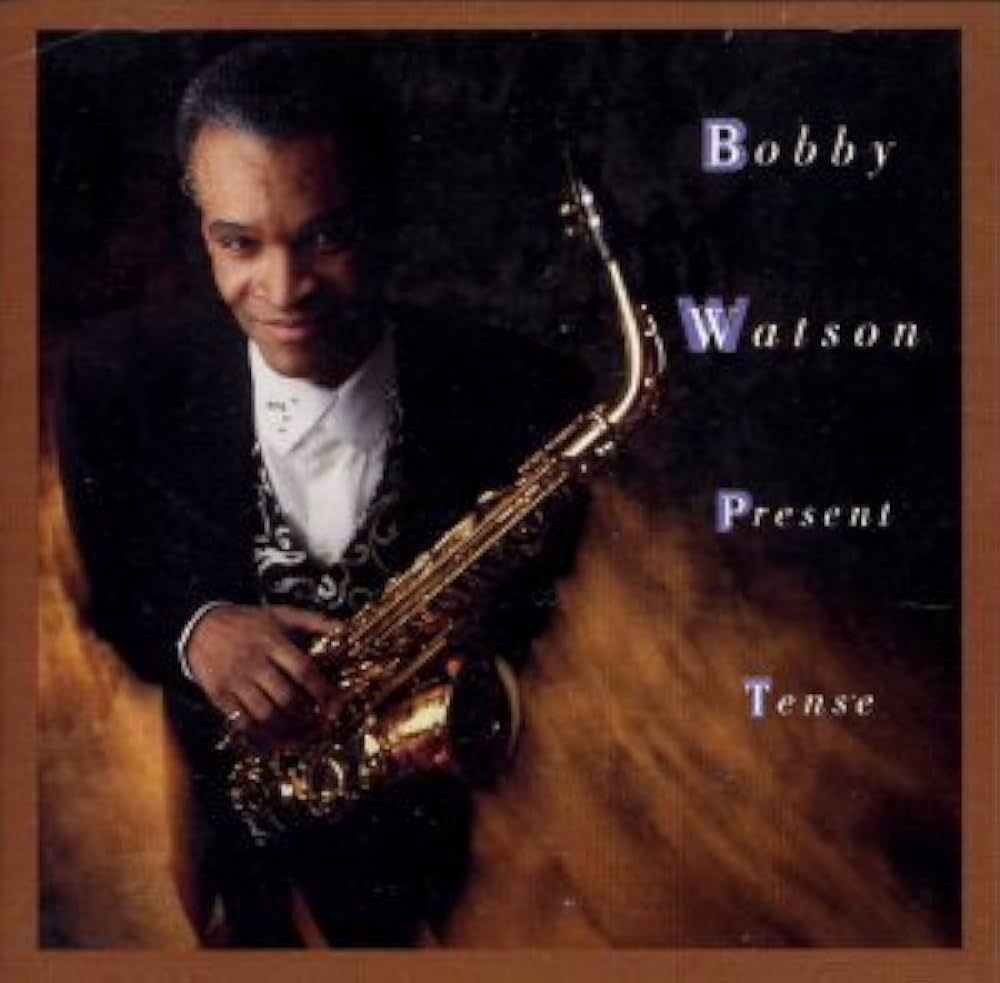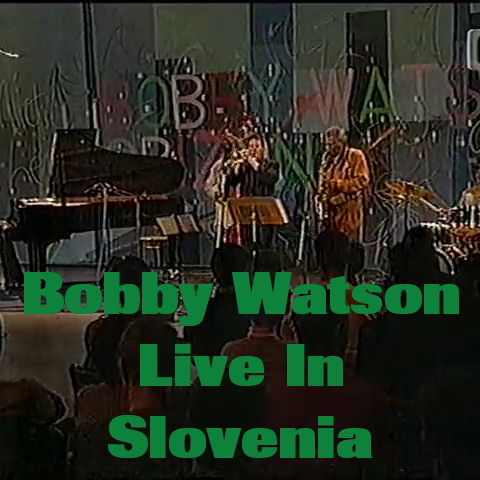Monk He See, Monk He Do – Robert Watson
Bobby Watson's tribute to Thelonious Monk is a bouncy medium swinger with a lot of rhythm section hits. Second parts are available for the two-horn arrangement.
- Recording: Bobby Watson - Present Tense
- Recorded on: December 9-11, 1991
- Label: Columbia (CK 52400)
- Concert Key: C
- Vocal Range: , to
- Style: Swing (medium)
- Trumpet - Terell Stafford
- Alto Sax - Bobby Watson
- Piano - Edward Simon
- Bass - Essiet Essiet
- Drums - Victor Lewis
Video
- Description
- Historical Notes
- Solos
- Piano Corner
- Bass Corner
- Drum Corner
- Guitar Corner
- Inside & Beyond
- Minus You
Bobby Watson's tribute to Thelonious Monk focuses on Monk's rhythmic feel, while still being recognizably a Watson composition. Repeated staccato quarter notes give the A section theme a Monkish bounce, with an angular quality coming from a pickup that rises and falls in fourths. The A section is nine measures long, with piano and bass hits on beat 1 and the "and" of beat 2 for the first five measures followed by longer syncopated rhythm section hits (with the melody) on the last four. After the two A sections, there is an eight-measure B section that alternates between two measures of ensemble hits and two measures of drum fills. The C section starts with a more melodic, rising phrase before going back to Monk-land in the fifth measure, with angular staccato figures over rhythm section "stride". A break in the seventh measure of this section leads to longer rhythm section chords, for a nine-measure C section. The D section is the same as A.
The changes also give this song some of its Monk feeling. The melody of the A section is entirely diatonic in C major, but the changes begin by alternating A♭7 and B♭7, making the melody notes ♯11ths and 13ths, before a final resolution to C. The B and C section changes have a lot of chromatic motion and sequential resolutions, while the end of the C section uses a whole-tone quality to sound especially Monkish.
Solos are on almost the same form as the head, but with the C section one measure shorter at the end for an even eight measures. On this recording, the solos are each one chorus long. The rhythm section plays the same figures from the head on the A sections (E and F in the solo form), going to 4-feel on the bridge. The break on the seventh measure of C (H in the solos) is played in every solo chorus, while the last section of the solo form continues the 4-feel and goes back to the hits after five measures.
There is an intro which repeats the rhythm section figures from the beginning of the head for eight measures. The coda repeats the last four measures of the head, followed by the last three measures again.
About the arrangement: The first two notes of the A section theme are voiced in major seconds, which accentuate the Monk influence. The alto sax alone plays the melody in the first four measures of C, with the trumpet entering in the fifth measure. The second half of the C section has the horns voiced in more angular intervals including tritones and major sevenths.
The changes also give this song some of its Monk feeling. The melody of the A section is entirely diatonic in C major, but the changes begin by alternating A♭7 and B♭7, making the melody notes ♯11ths and 13ths, before a final resolution to C. The B and C section changes have a lot of chromatic motion and sequential resolutions, while the end of the C section uses a whole-tone quality to sound especially Monkish.
Solos are on almost the same form as the head, but with the C section one measure shorter at the end for an even eight measures. On this recording, the solos are each one chorus long. The rhythm section plays the same figures from the head on the A sections (E and F in the solo form), going to 4-feel on the bridge. The break on the seventh measure of C (H in the solos) is played in every solo chorus, while the last section of the solo form continues the 4-feel and goes back to the hits after five measures.
There is an intro which repeats the rhythm section figures from the beginning of the head for eight measures. The coda repeats the last four measures of the head, followed by the last three measures again.
About the arrangement: The first two notes of the A section theme are voiced in major seconds, which accentuate the Monk influence. The alto sax alone plays the melody in the first four measures of C, with the trumpet entering in the fifth measure. The second half of the C section has the horns voiced in more angular intervals including tritones and major sevenths.
"Present Tense" was the first of three albums featuring this lineup of Bobby Watson's Horizon quintet. Two years later, the same quartet recorded a live album, "Midwest Shuffle." The third album with this personnel is 2004's reunion, "Horizon Reassembled." Pianist Edward Simon first recorded with Bobby on the third Horizon album, "The Inventor", in 1989.
Related Songs
Email Send Monk He See, Monk He Do to a friend
Send this page to a friend via email. Add your name or email in the first field. In the second, add one or more email addresses, separated by a comma.
- Recording: Bobby Watson - Live In Slovenia
- Recorded on: October 25, 2000
- Label: RTV Studio, Slovenia ()
- Concert Key: C
- Vocal Range: , to
- Style: Swing (medium)
- Trumpet - Jack Walrath
- Alto Sax - Bobby Watson
- Piano - Orrin Evans
- Bass - Curtis Lundy
- Drums - Victor Lewis
- Description
- Historical Notes
- Solos
- Piano Corner
- Bass Corner
- Drum Corner
- Guitar Corner
- Inside & Beyond
- Minus You
This live version is a bit slower than the studio recording. The trumpet and piano solos are two choruses each, while Bobby's solo between them is three choruses. The break in the seventh measure of H is played on every chorus. In the horn solos, the rhythm section continues the hits at I of each soloist's first chorus, and then goes to 4-feel at the beginning of the next chorus. The piano solo is a little looser, without hits on the first five measures of I in the first chorus. In other choruses, the I section is played differently each time. Jack Walrath ends his trumpet solo a section early, and the rhythm section plays hits through I of that chorus. Bobby's second chorus has 4-feel through I; the third chorus starts I with 4-feel and the hits come in on the last four measures. The second piano solo chorus has the same format at I.
Orrin Evans plays a solo piano intro, at a faster tempo than the rest of the song (not in our audio clip). In this version the out head is abbreviated: after the piano solo, the horns come in and play the last section of the melody straight to the coda.
Orrin Evans plays a solo piano intro, at a faster tempo than the rest of the song (not in our audio clip). In this version the out head is abbreviated: after the piano solo, the horns come in and play the last section of the melody straight to the coda.
This recording comes from a TV broadcast in Ljubljana, Slovenia. For another song from this broadcast check out Ode For Aaron. Pianist Orrin Evans, who does a great job channeling Monk in his solo intro, first recorded with Bobby Watson on the latter's 1998 album "Quiet As It's Kept." Trumpeter Jack Walrath hasn't yet recorded on an album with Bobby as the sole leader, but the two have played together extensively since the '80s. Two albums by The Jazz Tribe, a sextet co-led by Bobby and percussionist Ray Mantilla, have featured a personnel very similar to that heard on this broadcast, with Walrath, Curtis Lundy, and Victor Lewis. One of these, 1999's "The Next Step," has Ronnie Mathews on piano, while "Everlasting" from 2008 has the same lineup except with pianist Xavier Davis.
Related Songs
Email Send Monk He See, Monk He Do to a friend
Send this page to a friend via email. Add your name or email in the first field. In the second, add one or more email addresses, separated by a comma.

Robert Watson
born on August 23, 1953
Robert "Bobby" Watson, who was born and raised in Kansas City, Kansas, grew up to become a jazz saxophonist, composer, arranger and education of formidable talent and acclaim. He got his degree from the University of Miami before becoming a member (and later the musical director) of legendary drummer Art Blakey's Jazz Messengers. He remained an invaluable member for four years, from 1977 until 1981. Read more...
There was a problem.
...




